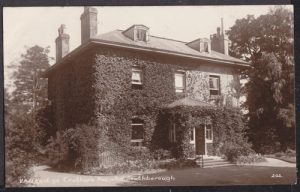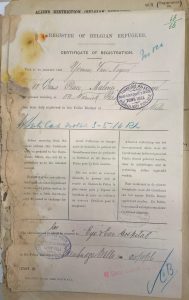In 1914 Southborough was quite a small village, separated by three miles of open country from the more elegant Tunbridge Wells but very much connected to High Brooms with its Brick Works and Railway station. I am fascinated by the significant proportion of the 300 or so refugees from Belgium who found themselves living in the same bit of Southborough in which I have made my home. Number 9 Argyle Rd was, at that time, a girls’ boarding school run by Ellen Watson. Ellen devoted her lifetime to the education of girls from 1881 to 1922. Further up Pennington Road, Ellen’s neighbour Robertina Crothers was living a very different life.
Robertina Crothers was appointed with 23 others to serve on Mayor Emson’s committee for Belgian Refugees on 15th October 1914. Robertina owned a very large house in what has now become Colonel’s Way (later known as Crothers VAD hospital) but was living in another impressive house, which she also owned, near the London Road end of Pennington. She was one of the first people to offer accommodation to the Belgians. A Courier article of 18th September 1914 reported that 72 Pennington Rd had been “placed at the disposal of the Committee”.

72 Pennington Road/Crothers hospital
The photo above shows a large property, set in extensive grounds, providing accommodation for two large Belgian families: the Denyns – six children between the ages of 10 and 19, their parents and an aunt (Mrs. Denyn’s sister); also the Van Noyens, a mother and father plus five youngsters between 13 and 20.

The Denyn children are listed in the “Scott Album” by name as Madeleine, Juliette, Adolphe, Jeanne, Laura, and Emma, with their parents Joseph, the famous carilloneur of Malines Cathedral, and Helene. The two older children were sent away to school in London while the four younger ones attended the Mark Cross Convent – which later became the home of the Legat Ballet School (where I attended rehearsals for a production of “The Crucible” in 1990 and found it an interesting but somewhat creepy building with winding corridors and small , dark rooms!) and then an Islamic boarding school.
In Feb 1915, the Denyns were listed in a document regarding the “employment of Belgian males” held in Maidstone Archives as the only Belgians living in Southborough.

Sometime after that they moved to 3 East Cliff Road where they remained until early 1918. The youngest daughter Emma died aged 12 on 28 September 1916 at 3 East Cliff Road – cause of death “Status Epilepticus”. Her mother, Helene Denyn died a year later on 23rd Sepember 1917 from pneumonia, also at number 3 Eastcliff Rd. Both are buried at Hawkenbury Cemetary.

The other family housed in Southborough courtesy of Robertina Crothers were the Van Noyen family: banker Armand, his wife, and 5 of their 6 children, a daughter and 4 sons.
In the 1911 census, apart from the 13 pupils registered as living at Argyle House School with 71 year old head of the school, Ellen Watson, was a 27 year old Belgian woman teacher – Elvire Meternach; nothing more is known about Elvire though it can be supposed that she taught the girls some French during her stay, this of course was four years previous to the arrival of the other two families.

The Kent and Sussex Courier of 30/06/1916 has a glowing account of “a Garden Play” entitled ‘The Bride of the Emperor’ being performed by Argyle House pupils up at the Crothers Hospital for the wounded soldiers being cared for up there . The audience numbered over 200 and the girls spoke up “with good dramatic force and clear enunciation.”
I like to imagine the friendship that must have flourished between the dedicated Head Teacher – Ellen Watson, obviously so devoted to her girls and to running Argyle House – and her affluent neighbour Robertina Crothers, living at the other end of Pennington Road but spending a great deal of time travelling in Europe with her great friend Miss Lushington.

I like to picture the two neighbours planning welcoming and fund raising events together, both for the Belgian refugee families, suddenly in their midst until they moved up the London Road to what is now St John’s — and later on for the benefit of the wounded and recovering soldiers.
One last, somewhat sad little event among the many recorded, was of a young Belgian lad living at 72 Pennington Road – perhaps 13 year-old Hector Van Noyen? – being knocked off his bike at the junction of Speldhurst and London road and taken in by Mrs Blackburn Maze, with bruises and a badly smashed up bike. So that road junction was hazardous back in October 1914. (reported in Courier of 30th October 1914)
______________________________________________________________
More about the Van Noyen family from Alison MacKenzie:
Youngest son Hector was at Skinners 1914- December 1917 according to The Leopard, the Skinner’s School magazine, of the time. The other 3 sons were students in London and the oldest had joined the Belgian Army,
Armand Van Noyen was on the Committee of the Club Albert in December 1914, but not in July 1916 when the album was presented to the Misses Scott, and the fact that he was not on the list of Belgian men available for work in February 1915 suggests they had left the area by then.
However we do have registration documents for daughter Yvonne which show that she moved from Pennington Road to 52 Warwick Park in summer 1915, and then in early 1916 moved on to work as a nurse at the Eye and Ear Hospital, 22 Mount Sion; from where she went to Cheshire in the autumn of 1916. The family had left the area by January 1917 according to Armand Van Noyen’s registration document.

Sources
Report of the Tunbridge Wells Refugees’ Committee 1919
Kent and Sussex Courier
Findmypast.com
